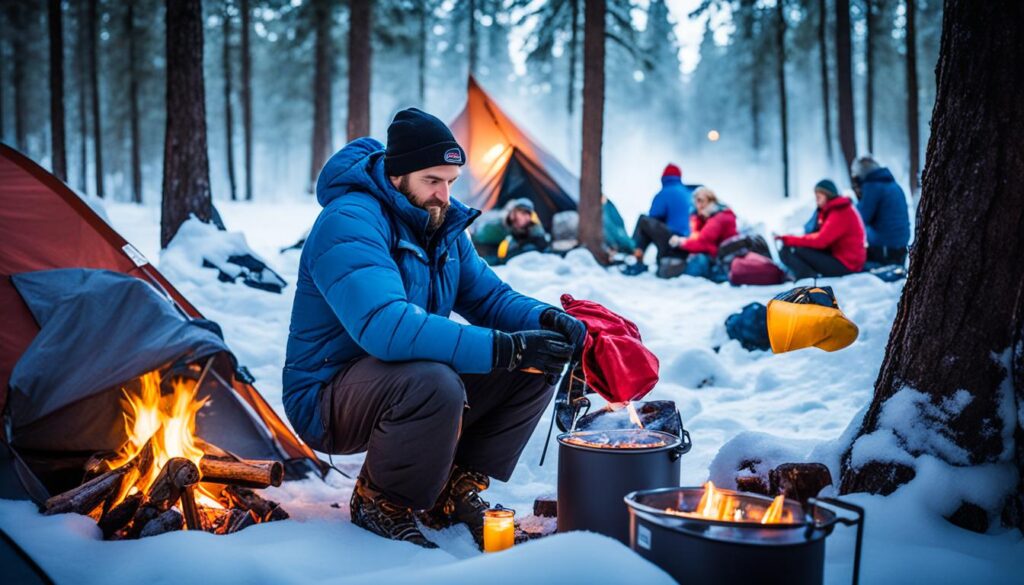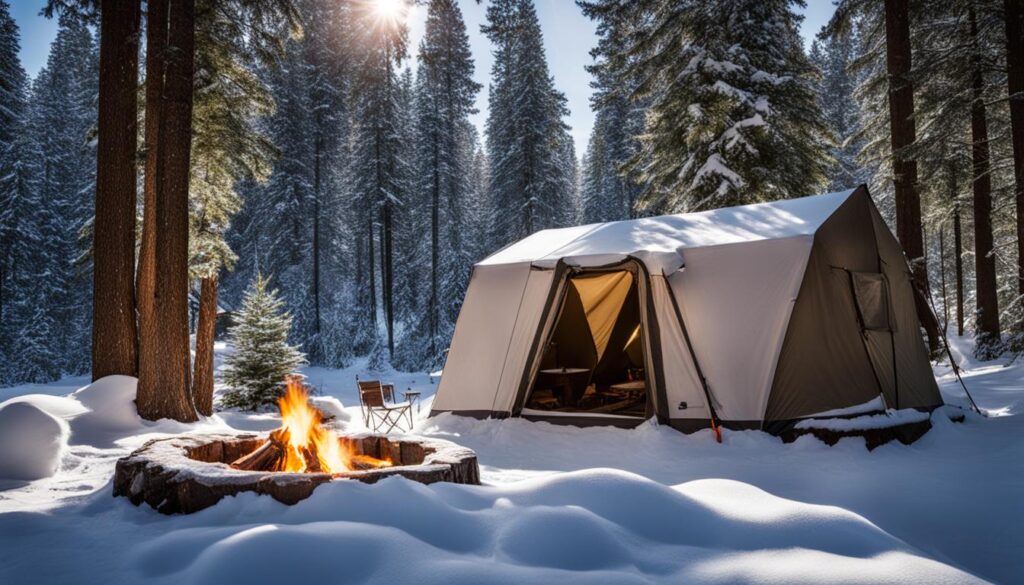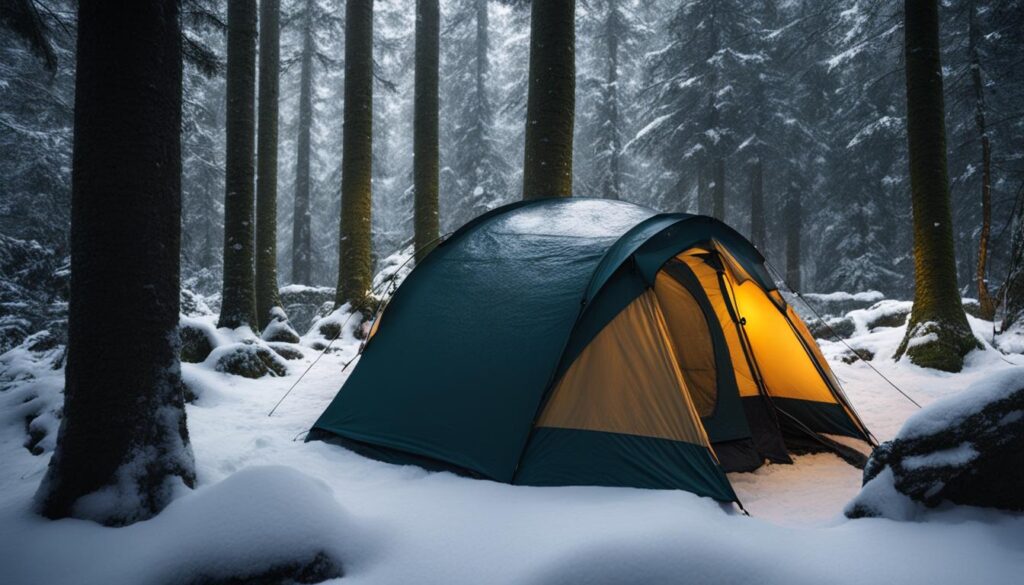When camping in cold weather, it’s important to take steps to stay warm and comfortable. Whether you’re a seasoned camper or a beginner, staying cozy while camping is crucial for an enjoyable outdoor experience. From clothing to gear and insider hacks, I’ve got you covered with these essential tips and tricks for staying warm while camping.
Key Takeaways:
- Layer up with moisture-wicking base layers, insulating midlayers, and a waterproof shell to stay warm in chilly conditions.
- Choose the right gear, including a sleeping bag with a temperature rating lower than the expected lows, insulated sleeping pads, and a winter tent.
- Select a sheltered campsite that blocks the wind and receives morning sun for natural warmth.
- Prevent condensation in your tent by proper ventilation and minimizing moisture inside.
- Insulate your sleeping arrangement with a warm sleeping bag, sleeping bag liner, and insulated sleeping pads.
- Stay hydrated, eat high-calorie foods, warm up your core, and use hand and toe warmers for additional warmth.
- Wear proper winter camping clothing, including hats, gloves, and warm socks.
Layer Up to Stay Warm
When it comes to camping in cold weather, layering is your best friend. Layering allows you to easily adjust your clothing to regulate your body temperature, keeping you warm and comfortable throughout your camping trip. Here’s how to layer your clothing effectively for cold weather camping:
1. Base Layers for Cold Weather Camping
Start with a base layer of moisture-wicking long underwear. These base layers are designed to keep moisture away from your skin, preventing you from feeling damp and chilly. Look for base layers made from materials like merino wool or synthetic fabrics.
2. Midlayers for Staying Warm While Camping
After your base layer, add insulating midlayers for extra warmth. Fleece jackets, sweaters, or down vests are excellent choices for midlayers. These materials trap heat close to your body and provide insulation without adding too much bulk.
3. Outerwear for Cold Weather Camping
Once you have your base and midlayers, it’s time to protect yourself from the elements with proper outerwear. Invest in a waterproof and breathable shell jacket or parka to shield yourself from rain, snow, and wind. Look for features like adjustable hoods, zippered vents, and sealed seams for added protection.
Remember, the outerwear should be slightly larger than your other layers to accommodate them comfortably.
Adding extra layers under your sleeping bag can also help keep you warm at night. Consider using a blanket or a thermal liner to provide additional insulation.
Layering your clothing is crucial when camping in cold weather. It allows you to easily adjust your temperature by adding or removing layers as needed. By starting with a moisture-wicking base layer, adding insulating midlayers, and topping it off with a waterproof shell, you can stay warm and comfortable throughout your camping adventure.
Choose the Right Gear for Cold Weather Camping
When it comes to camping in cold weather, having the right gear is essential for staying warm and comfortable. From sleeping bags to tents, here’s a guide to help you choose the essential gear for your cold weather camping adventures.
Sleeping Bags for Cold Weather Camping
A high-quality sleeping bag is a must-have for camping in cold temperatures. Look for a sleeping bag that has a temperature rating lower than the expected low temperatures of your camping destination. This ensures that you stay warm throughout the night.
There are different types of sleeping bags available, including mummy bags and rectangular bags. Mummy bags are more form-fitting and offer better insulation, while rectangular bags provide more room to move around. Consider your personal preferences and choose a sleeping bag that suits your needs.
Here are a few options to consider:
| Sleeping Bag | Temperature Rating | Features |
|---|---|---|
| North Face Inferno | -20°F | Water-resistant and durable |
| Marmot Trestles Elite Eco | 15°F | Recycled materials and lightweight |
| REI Co-op Trailbreak | 20°F | Affordable and versatile |
Insulated Sleeping Pads
Don’t forget about the importance of insulation from the cold ground. Insulated sleeping pads provide an additional layer of warmth and insulation. They help prevent the cold ground from sucking heat away from your body.
Look for sleeping pads with insulation, such as foam or synthetic insulation. They provide better insulation compared to regular air mattresses or non-insulated sleeping pads. Consider the R-value, which measures the pad’s thermal resistance. The higher the R-value, the better the insulation.
Choosing a Winter Tent
A winter tent is specifically designed to withstand harsh weather conditions, such as wind and snow. It provides more insulation and protection compared to regular tents. When choosing a winter tent, look for the following features:
- Sturdy construction: The tent should be made from durable and strong materials.
- Waterproof: It should have a waterproof rainfly and seams to keep you dry in wet conditions.
- Snow flaps: These are extra fabric panels designed to prevent snow from entering the tent.
- Size: Opt for a smaller tent to trap in heat more effectively.
Here are a few winter tent options to consider:
| Winter Tent | Capacity | Features |
|---|---|---|
| MSR Access 2 | 2-person | Lightweight and easy to set up |
| The North Face Mountain 25 | 2-person | Durable and withstands extreme weather conditions |
| Big Agnes Battle Mountain 3 | 3-person | Spacious and excellent ventilation |
Choosing the right gear will make a world of difference in ensuring a warm and enjoyable camping experience in cold weather. With the right sleeping bag, insulated sleeping pads, and winter tent, you’ll be ready to brave the elements and create unforgettable memories.

Find the Perfect Campsite
When it comes to cold weather camping, choosing the right campsite can make a world of difference in your comfort level. A well-selected campsite can offer protection from the wind and provide natural warmth from the sun. Let me share with you some essential tips for finding the perfect campsite for your cold weather adventure.
Choosing a Sheltered Campsite
One of the key considerations when selecting a campsite for cold weather camping is finding an area that is sheltered from strong winds. Wind can quickly strip away body heat and make even the mildest temperatures feel much colder. Look for a campsite that is naturally shielded from the wind, such as behind a ridge or in a clump of trees. This will help create a barrier to protect your camping area and keep you warmer throughout the night.
Opting for a Sunny Campsite
Another important aspect to consider is finding a campsite that receives ample sunlight, especially in the morning. The sun can provide natural warmth that helps offset the chilly temperatures. Look for an area that is not blocked by tall trees or mountains, allowing the sun’s rays to reach your campsite. Starting your day with the warmth of the sun can make your camping experience much more enjoyable.
Lower Elevations for Warmer Camping
Elevation plays a significant role in temperature variations, with higher elevations tending to be colder. Consider camping at lower elevations, as the temperatures are generally milder compared to higher peaks. This can make a notable difference when it comes to staying warm. Be mindful of the elevation of your chosen campsite, and opt for lower areas if possible.
“Choosing a campsite that is sheltered from the wind and receives morning sunlight can greatly enhance your cold weather camping experience.”
To summarize, finding the perfect campsite for cold weather camping involves selecting a sheltered location, opting for a sunny spot, and considering lower elevations. Taking these factors into account will greatly contribute to your overall comfort and warmth during your camping trip.

Campsite Checklist
Use this checklist to find the ideal campsite for your cold weather adventure:
| Factors to Consider | Selection Criteria |
|---|---|
| Wind Protection | – Choose a location behind a ridge or trees – Look for natural barriers against strong winds |
| Morning Sun | – Find an open area with unobstructed sunlight – Ensure the campsite receives ample morning sun |
| Elevation | – Opt for lower elevations – Avoid camping at higher peaks |
Tips for Dealing with Condensation
Condensation can be a common challenge when camping in cold weather. Excessive moisture inside your tent can make the camping experience uncomfortable and even lead to damp gear. To prevent condensation and keep your tent dry, follow these helpful tips:
- Proper Ventilation: Ensure your tent is well-ventilated by opening vents or partially unzipping the door. This allows for better airflow, reducing the chances of condensation.
- Pitching your Tent: When setting up your tent, make sure it is pitched tightly to minimize gaps and allow moisture to pass through the mesh or fabric inner panels. This ensures proper ventilation throughout the tent.
- Minimize Snow Entry: Try to minimize the amount of snow that enters the tent when entering or exiting. This will help reduce the overall humidity levels inside.
By implementing these tips, you can effectively prevent condensation in your tent and maintain a comfortable and dry camping environment in winter weather.
“Proper ventilation and effective pitching are crucial for preventing condensation in your tent during cold weather camping.”

| Preventing Condensation in Your Tent | |
|---|---|
| 1 | Ensure proper ventilation by opening vents or partially unzipping the door. |
| 2 | Pitch your tent tightly to allow moisture to pass through the mesh or fabric inner panels. |
| 3 | Minimize the amount of snow brought inside the tent to reduce humidity. |
Insulation Tips for Sleeping Warm
Keeping warm while sleeping is crucial for a comfortable camping experience. When camping in cold weather, it’s important to choose the right gear and insulation techniques to stay cozy throughout the night.
Choosing a Warm Sleeping Bag
One of the most important considerations for sleeping warm is choosing a suitable sleeping bag. Look for a sleeping bag with a temperature rating lower than the expected low temperatures during your camping trip. This ensures that the sleeping bag provides adequate insulation to keep you warm. Brands like The North Face and Marmot offer a wide range of high-quality sleeping bags specifically designed for cold weather camping.
Using a Sleeping Bag Liner for Extra Warmth
For additional warmth, you can use a sleeping bag liner in conjunction with your sleeping bag. A sleeping bag liner is a lightweight and compact sheet that fits inside your sleeping bag. It adds an extra layer of insulation and helps trap body heat, keeping you warmer throughout the night. Sea to Summit and Therm-a-Rest offer excellent sleeping bag liners that are highly recommended for cold weather camping.
Layering Sleeping Bags for Extra Insulation
To maximize insulation, you can layer sleeping bags together. This technique involves using two sleeping bags, one inside the other. Start with a warmer sleeping bag as the base and insert a lighter sleeping bag inside for additional insulation. This layering method provides extra warmth and is often used by experienced cold weather campers.
Insulated Sleeping Pads for Winter Camping
Insulated sleeping pads are another essential piece of gear for winter camping. These pads provide insulation from the cold ground and help retain body heat. Look for sleeping pads with built-in insulation or ones that use advanced materials like down or foam to prevent heat loss. Popular brands such as Therm-a-Rest and Exped offer a range of insulated sleeping pads suitable for winter camping.
| Insulation Tip | Benefits |
|---|---|
| Choose a Warm Sleeping Bag | – Provides adequate insulation – Keeps you warm in cold temperatures – Brands: The North Face, Marmot |
| Use a Sleeping Bag Liner | – Adds extra layer of insulation – Traps body heat – Brands: Sea to Summit, Therm-a-Rest |
| Layering Sleeping Bags | – Provides additional warmth – Maximizes insulation – Common technique among experienced campers |
| Insulated Sleeping Pads | – Offers insulation from cold ground – Retains body heat – Brands: Therm-a-Rest, Exped |
Additional Tips for Staying Warm
When it comes to camping in cold weather, there are a few extra strategies that can help you stay warm and cozy throughout your outdoor adventure. One crucial aspect to consider is staying hydrated. Even though it may not seem as important as in warmer weather, staying hydrated is essential for regulating your body temperature in cold conditions.
Additionally, eating and drinking warm foods can provide an extra boost of heat. Consuming high-calorie meals and warm beverages will not only provide your body with the necessary fuel but also help maintain your internal temperature.
To warm up your core, consider using hot water bottles or dressing in warm layers. Hot water bottles can be placed inside your sleeping bag or next to your body to provide a cozy source of heat. Layering up with proper winter camping clothing, including hats, gloves, and warm socks, will help insulate your body and prevent heat loss.
Lastly, hand warmers and toe warmers can provide additional comfort in extremely cold temperatures. These small disposable warmers can be easily activated and placed inside your gloves, socks, or boots to keep your digits toasty and warm.
FAQ
How can I stay warm when camping in cold weather?
To stay warm when camping in cold weather, it’s important to layer your clothing, choose the right gear, find a sheltered campsite, deal with condensation, insulate your sleeping arrangements, and follow additional tips for staying warm.
What is the best way to layer clothing for cold weather camping?
Layering is essential for staying warm while camping in cold weather. Start with a moisture-wicking base layer, add insulating midlayers, and top it off with a waterproof shell. Don’t forget to layer extra clothing underneath your sleeping bag for added warmth.
What gear should I choose for cold weather camping?
For cold weather camping, choose a sleeping bag with a lower temperature rating, insulated sleeping pads, and a winter tent that can withstand wind and snow. Opt for smaller tents for better heat retention.
How should I choose a campsite for cold weather camping?
Look for a campsite that is sheltered from the wind, such as behind a ridge or in a clump of trees. Choose a campsite that receives morning sun for natural warmth, and consider camping at lower elevations as they tend to be warmer.
How can I prevent condensation in my tent while camping in cold weather?
To prevent condensation, ensure your tent is properly ventilated by opening vents or partially unzipping the door. Pitch your tent tightly to allow moisture to pass through the mesh or fabric inner panels, and minimize bringing snow inside the tent.
How can I insulate my sleeping arrangements to stay warm?
Choose a sleeping bag with a lower temperature rating than the expected low temperatures. Consider using a sleeping bag liner for extra warmth, and layer sleeping bags for additional insulation. Use insulated sleeping pads to provide insulation from the cold ground.
Are there any additional tips for staying warm while camping in cold weather?
Yes, you should stay hydrated and eat high-calorie foods to maintain your body temperature. Warm up your core with hot water bottles or warm clothing. Use hand warmers and toe warmers for extra warmth, and dress in proper winter camping clothing, including hats, gloves, and warm socks.

